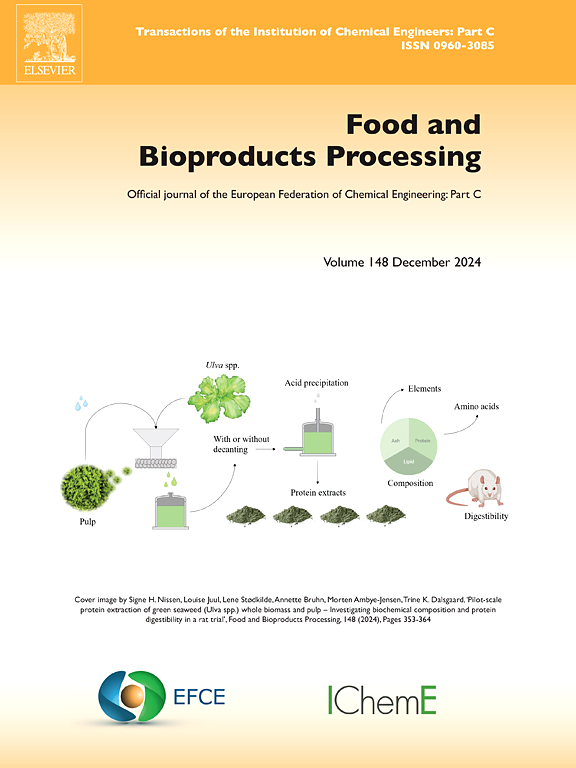CcCHIL, a type IV chalcone isomerase that can improve (2S)-naringenin production in Saccharomyces cerevisiae
IF 3.5
2区 农林科学
Q2 BIOTECHNOLOGY & APPLIED MICROBIOLOGY
引用次数: 0
Abstract
(2S)-Naringenin, a crucial precursor in plant flavonoid synthesis, holds significance in diverse biological processes and potential therapeutic applications for human diseases. The economically valuable Citrus reticulata 'Chachi' citrus cultivar, renowned for its flavonoid-rich peel, was subjected to integrated transcriptomic and metabolomic analysis in this study to reveal patterns of flavonoid accumulation. The analysis revealed a strong correlation between the expression pattern of the gene encoding type IV chalcone isomerase (chalcone isomerase like, CHIL), CcCHIL, and the accumulation of flavonoids in C. reticulata 'Chachi' peel. Previous studies have demonstrated that type IV chalcone isomerase can enhance flavonoid accumulation in citrus and improve the catalytic efficiency of chalcone synthase in vitro, thereby increasing the titer of (2S)-naringenin. In this study, we constructed a genetically engineered yeast strain capable of de novo synthesis of (2S)-naringenin. We found that CcCHIL can increase (2S)-naringenin production in engineered yeast by 13.60 %. Subsequently, we conducted experiments using CHILs from various species and found that GmCHIL from Glycine max can increase (2S)-naringenin production in engineered yeast by 45.35 %. Sequence alignment, molecular docking predictions and site-directed mutagenesis showed that Asn151 is one of the key sites for CHIL improving (2S)-naringenin production. Our study unveiled CcCHIL's crucial role in flavonoid biosynthesis in C. reticulata 'Chachi' peel and paving the way for future synthesis of intricate and economically valuable flavonoids.
CcCHIL 是一种 IV 型查尔酮异构酶,可提高酿酒酵母中 (2S) 柚皮苷的产量
(2S)-柚皮苷是植物类黄酮合成过程中的一种重要前体物,在多种生物过程中具有重要意义,对人类疾病具有潜在的治疗作用。本研究对以果皮富含类黄酮而闻名的具有经济价值的柑橘栽培品种Citrus reticulata 'Chachi'进行了转录组和代谢组的综合分析,以揭示类黄酮的积累模式。分析结果表明,编码 IV 型查尔酮异构酶(类似查尔酮异构酶,CHIL)的基因 CcCHIL 的表达模式与 C. reticulata 'Chachi' 果皮中黄酮类化合物的积累之间存在很强的相关性。以前的研究表明,IV型查尔酮异构酶能增强柑橘中黄酮类化合物的积累,提高查尔酮合成酶在体外的催化效率,从而提高(2S)-柚皮苷的滴度。在这项研究中,我们构建了一种能够从头合成(2S)-柚皮苷的基因工程酵母菌株。我们发现,CcCHIL 可使工程酵母菌的(2S)-柚皮苷产量增加 13.60%。随后,我们利用不同物种的 CHIL 进行了实验,发现来自 Glycine max 的 GmCHIL 能使工程酵母的 (2S)- 柚皮苷产量提高 45.35%。序列比对、分子对接预测和定点突变表明,Asn151是CHIL提高(2S)-柚皮苷产量的关键位点之一。我们的研究揭示了 CcCHIL 在 C. reticulata 'Chachi' 果皮类黄酮生物合成中的关键作用,为将来合成复杂且具有经济价值的类黄酮铺平了道路。
本文章由计算机程序翻译,如有差异,请以英文原文为准。
求助全文
约1分钟内获得全文
求助全文
来源期刊

Food and Bioproducts Processing
工程技术-工程:化工
CiteScore
9.70
自引率
4.30%
发文量
115
审稿时长
24 days
期刊介绍:
Official Journal of the European Federation of Chemical Engineering:
Part C
FBP aims to be the principal international journal for publication of high quality, original papers in the branches of engineering and science dedicated to the safe processing of biological products. It is the only journal to exploit the synergy between biotechnology, bioprocessing and food engineering.
Papers showing how research results can be used in engineering design, and accounts of experimental or theoretical research work bringing new perspectives to established principles, highlighting unsolved problems or indicating directions for future research, are particularly welcome. Contributions that deal with new developments in equipment or processes and that can be given quantitative expression are encouraged. The journal is especially interested in papers that extend the boundaries of food and bioproducts processing.
The journal has a strong emphasis on the interface between engineering and food or bioproducts. Papers that are not likely to be published are those:
• Primarily concerned with food formulation
• That use experimental design techniques to obtain response surfaces but gain little insight from them
• That are empirical and ignore established mechanistic models, e.g., empirical drying curves
• That are primarily concerned about sensory evaluation and colour
• Concern the extraction, encapsulation and/or antioxidant activity of a specific biological material without providing insight that could be applied to a similar but different material,
• Containing only chemical analyses of biological materials.
 求助内容:
求助内容: 应助结果提醒方式:
应助结果提醒方式:


